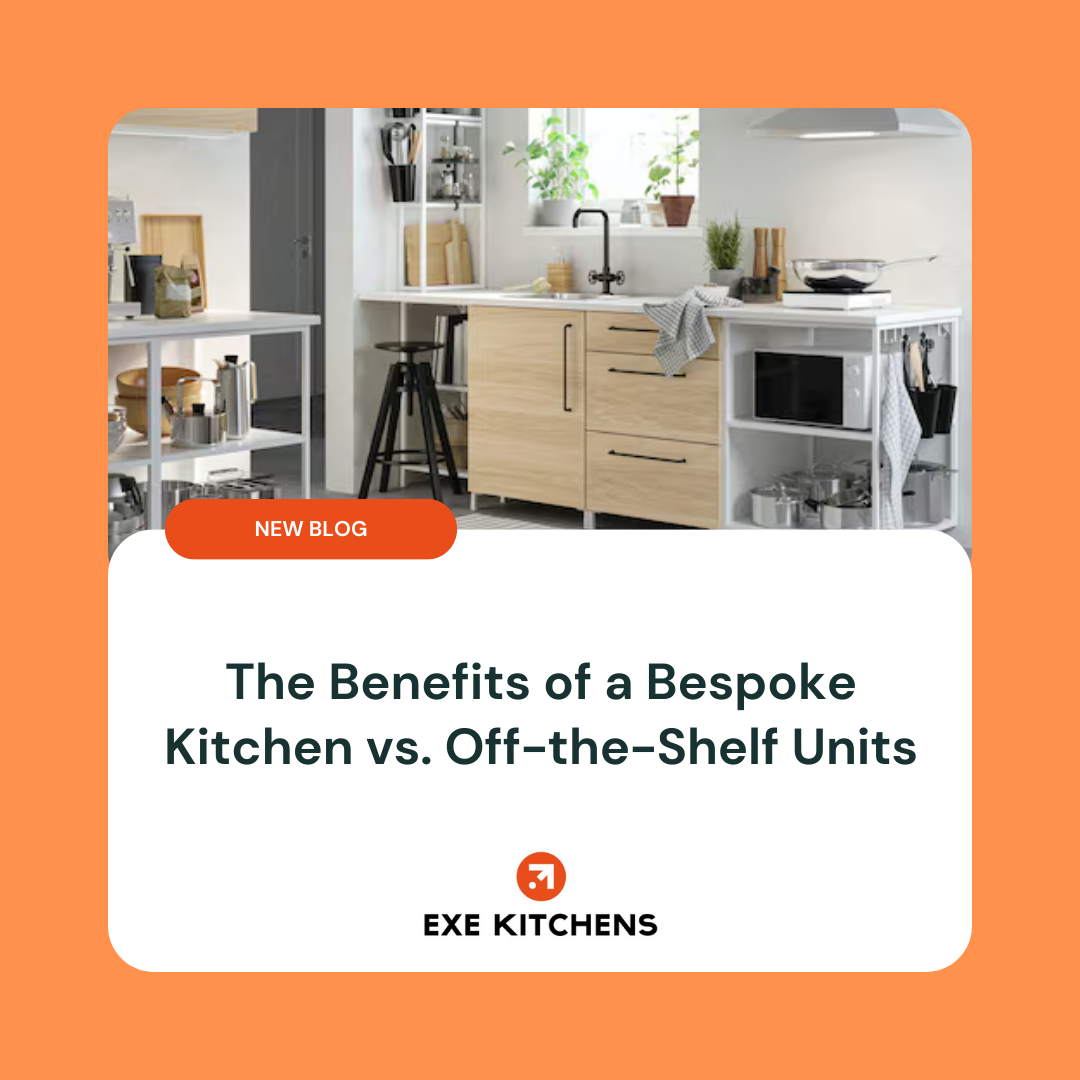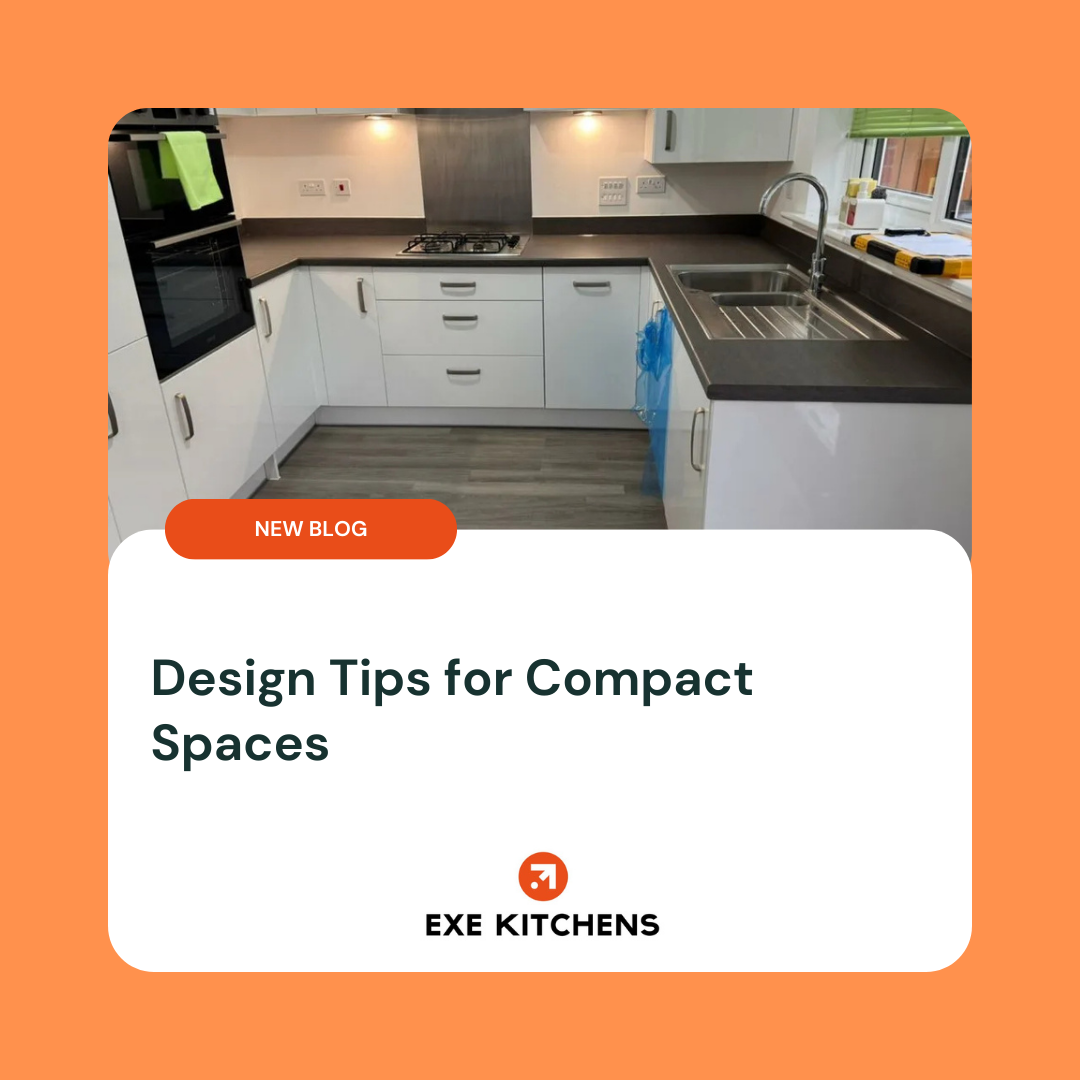Essential Kitchen Features for Homeowners: Top Appliances and Layout Tips
Every homeowner envisions a kitchen that ranks equally high in aesthetics and function. Whether whipping up gourmet meals or hosting memorable dinner parties, making the right choices can transform this space into the heart of your home.
Investing energy and time in creating an efficient, stylish kitchen without wasting resources is crucial—I’ve dived deep into researching what you truly need in terms of design and appliances. Surprisingly, there are specific features that stand out as essential for every homeowner’s kitchen transformation journey. Now, let’s explore those must-haves that will elevate both functionality and style seamlessly.
Essential kitchen features for homeowners include functional workspace, ample storage solutions, energy-efficient appliances, and effective lighting options. Additionally, incorporating an open layout and durable materials can enhance both usability and aesthetic appeal in your kitchen design.
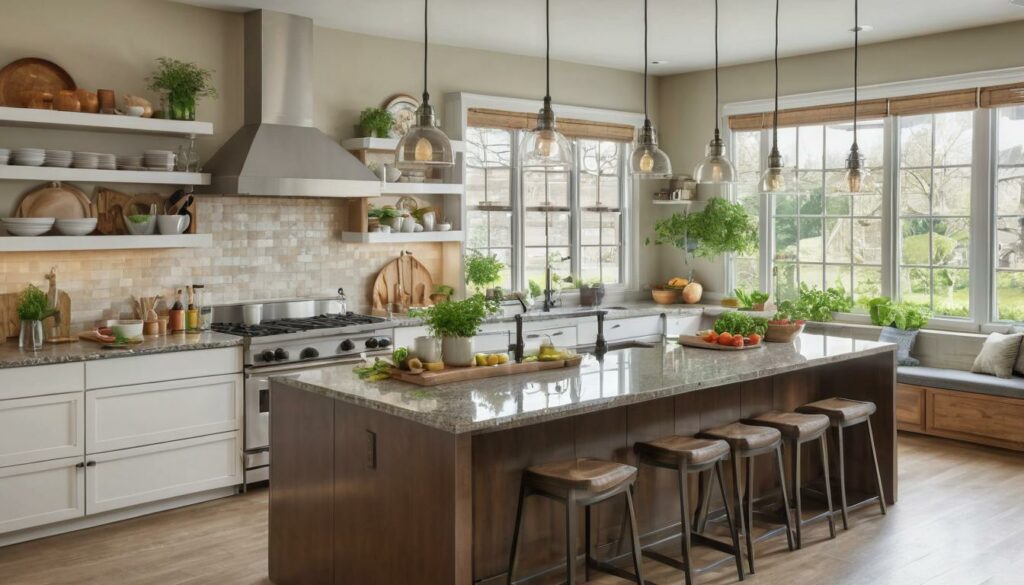
Essential Kitchen Features Every Homeowner Needs
Ample counter space forms the backbone of any well-designed kitchen. It’s not just about aesthetics; it’s about utility. Having sufficient countertops allows for meal preparation and baking, while providing room for essential appliances like mixmasters or coffee machines that often crowd smaller spaces.
When choosing materials, quartz and granite stand out as excellent options. Both are renowned for their durability, ability to resist staining, and ease of maintenance. These materials not only withstand daily wear and tear but also offer a timeless beauty that elevates your kitchen’s appearance.
As we explore what makes a kitchen truly functional, one feature that has gained immense popularity over the years is the kitchen island.
Functional Islands
Kitchen islands have soared in popularity due to their multifunctional benefits. They add much-needed counter space while serving various purposes—extra storage, additional seating for family and friends, or even a place to integrate appliances like microwaves or wine coolers.
The ability to prep meals while engaging with guests often turns these islands into the heart of the home. A recent survey by Houzz revealed that 33% of homeowners considered their newly installed kitchen islands as the top improvement in their renovations. This statistic illustrates how effective a well-placed island can be in enhancing both functionality and sociability in the kitchen.
Nevertheless, enhancing your kitchen goes beyond just counter space and islands—effective storage solutions are equally vital to its efficiency.
Essential Storage Solutions
Considering the number of tools, gadgets, and ingredients we keep in our kitchens, having ample storage is a must. Built-in features such as pull-out shelves allow easy access to pots and pans hidden away in deep cabinets, making cooking more enjoyable and less of a chore.
Carousel cabinets make excellent use of corner spaces often left unused, while deep drawers can accommodate larger items like mixing bowls or large pans without cluttering countertops. These solutions significantly enhance kitchen organization, making it easier to find what you need quickly while keeping things tidy.
Incorporating these essential features lays the groundwork for optimizing performance and functionality in your kitchen environment. Let’s now shift our focus toward selecting appliances that will elevate your culinary experience.
Selecting High-Performance Appliances
When it comes to choosing appliances for your kitchen, focus on ones that blend efficiency with functionality. The heart of a functional kitchen lies in these machines—appliances that not only work hard but also save you time and energy. Selecting high-performance appliances means investing in technology that can withstand daily use and help streamline your cooking tasks.
Modern Refrigerators
In today’s market, homes lean towards energy-efficient options. For instance, brands like LG and Samsung have introduced models equipped with smart cooling technology that can cut energy consumption by up to 30%. Beyond saving you money on utility bills, these fridges often come outfitted with features like built-in water dispensers and adjustable shelving, helping you organize your food while keeping everything fresh. It’s not just about cool temperatures; it’s about enhancing usability in your everyday routines.
Once you have the perfect refrigerator, consider how your cooking appliances can elevate your culinary arts.
High-Efficiency Ovens and Ranges
Now, if you’re passionate about cooking, think about a dual-fuel range. This combination merges the best aspects of gas stovetops—which offer high-temperature capabilities for searing—with electric ovens, known for their precise temperature control. This blend provides an exceptional cooking experience, allowing you to achieve restaurant-quality results at home. With features like self-cleaning options and convection technology, these ovens not only enhance performance but also make post-cooking cleanup less daunting.
After establishing cooking efficiency within your space, don’t forget about the importance of maintaining cleanliness as you cook.
Quiet and Effective Dishwashers
Lastly, don’t underestimate the role of an excellent dishwasher in your kitchen setup. Modern models from brands such as Bosch and Miele are leading the charge in silent operation paired with energy-efficient cycles. This means you can run your dishwasher at night without disturbing anyone’s rest while ensuring that dishes come out spotless every time. Many units also feature flexible racking systems that adapt to different dish sizes—a welcome advantage when hosting family dinners or gatherings.
By investing in high-performance appliances powered by innovative technology, you’re not just upgrading aesthetics; you’re fostering a seamless cooking experience and enhancing the lifespan of the kitchen itself.
Each appliance serves as a cornerstone of functionality that sets the stage for the next crucial aspect: optimizing your space for maximum efficiency and convenience.
Maximizing Storage Solutions
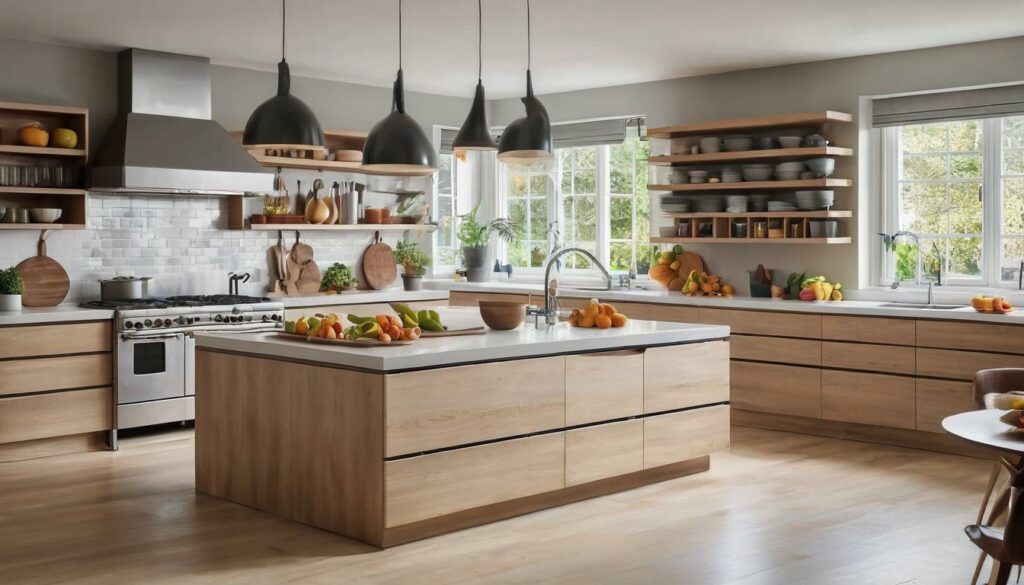
Storage is the backbone of an efficient kitchen. When planned correctly, it not only enhances functionality but also contributes to a pleasing aesthetic. A well-organized kitchen allows for smoother workflow during meal prep, making the cooking experience more enjoyable and less stressful. By utilizing space creatively, you can turn even the smallest kitchens into functional culinary havens.
Custom Cabinetry
Custom cabinetry plays a crucial role in maximizing storage and can be tailored to fit the unique dimensions of your kitchen. Not only do they provide ample space for all your cooking essentials, but they also have the flexibility to incorporate clever features like pull-out pantries that make accessing items at the back easy and convenient. You could integrate under-sink storage compartments that cleverly conceal cleaning supplies while still keeping them accessible.
According to studies conducted by the National Kitchen & Bath Association (NKBA), it’s evident that a staggering 76% of newly designed kitchens opt for customized cabinet solutions that seamlessly blend both storage and style, giving homeowners both form and function.
Innovative Shelving
Another approach to maximizing storage is through the incorporation of innovative shelving solutions. Consider open shelving, which promotes an airy feel while allowing you to display frequently-used dishes or glassware. This not only saves on cabinet space but also adds an artistic flair; think of it as showcasing your favorite cookbooks or spices as if they were part of a gallery. Floating shelves are particularly versatile, providing a sleek alternative to traditional cabinets, while rail systems with hooks can conveniently store utensils within arm’s reach—all while keeping your drawers clutter-free.
Adding vertical space doesn’t just end with cabinets; let’s explore how drawers can further revolutionize your kitchen organization.
Drawers and Dividers
Deep drawers equipped with built-in dividers work wonders in organizing everything from cooking utensils to pots and pans. The beauty of these drawers lies in their ability to hold larger items while ensuring that smaller tools don’t get lost or become jumbled together. Picture this: each utensil snugly nestled within its designated slot, making it effortless to find exactly what you need when you need it. This structured organization not only expedites meal prep but also combats clutter—a significant win for any busy kitchen.
Prioritizing innovative storage solutions is viewed as an investment in convenience as much as it is about maintaining a visually appealing space. Incorporating custom cabinetry, creative shelving, and organized drawers can drastically enhance both the functionality and appearance of your kitchen.
With an emphasis on effective storage solutions, we next shift focus to exploring robust materials that enhance both style and durability in your culinary space.
Durable Materials and Elegant Surfaces
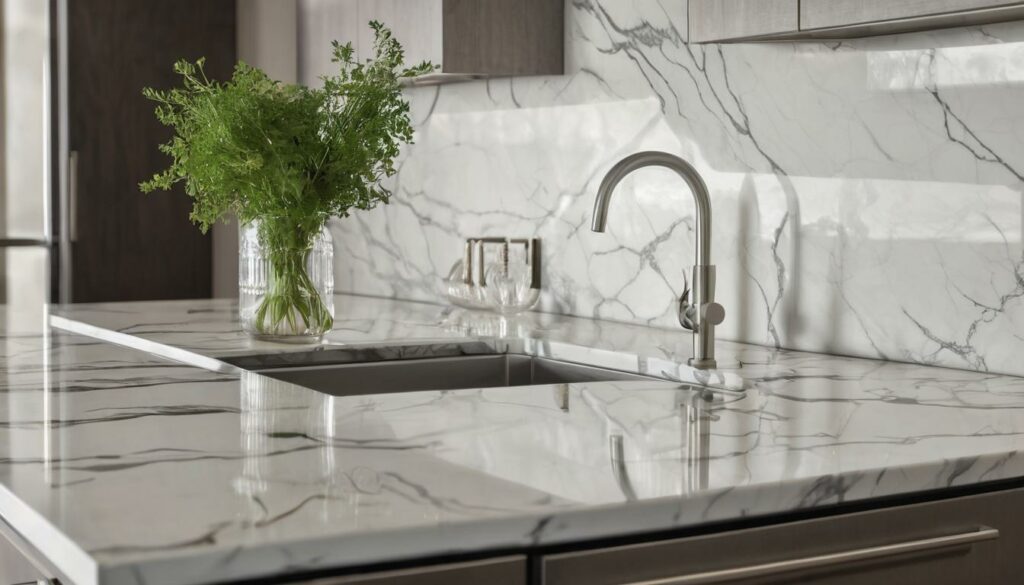
Durability and aesthetics can coexist seamlessly in your kitchen if you choose wisely. Selecting surfaces that are both robust and visually appealing creates a harmonious environment where you’ll enjoy cooking and gathering with family. Imagine cutting vegetables on a granite countertop that sparkles under the warm glow of overhead lights—a perfect blend of functionality and grace.
Countertop Options
Here’s a comparison of popular countertop materials:
| Material | Durability | Maintenance | Aesthetic Appeal |
|---|---|---|---|
| Granite | High | Low | Natural elegance |
| Quartz | High | Low | Versatile designs |
| Marble | Medium | High | Luxurious look |
| Laminate | Medium | Medium | Affordable |
As you can see from the table above, granite remains one of the most sought-after materials due to its exceptional durability and low maintenance needs. It’s an investment that pays off over time as it stands firm against scratches and spills.
Quartz offers similar durability but allows for creative designs that mimic natural stone without the upkeep concerns associated with real marble. Marble, while stunning, requires regular sealing to maintain its beauty, and laminate presents a budget-friendly alternative, although it may not endure heavy wear as well as its stone counterparts.
Flooring Choices
The flooring in your kitchen should complement your countertop selection while providing practicality. Ceramic tile, for example, is not only beautiful but also incredibly resistant to moisture—ideal for kitchens prone to spills and splashes. Hardwoods bring warmth into the space but require a bit more care; opting for species like oak or maple can offer longevity if treated correctly.
Choosing durable flooring options like ceramic tile or hardwood ensures ease of cleaning while standing up to high foot traffic. They will hold up even when things get hectic during meal preparations or family gatherings.
Once you’ve chosen your countertop and flooring, consider backsplash materials for added texture and flair. Glass tiles can reflect light beautifully, enhancing the space’s brightness, while stainless steel adds a sleek modern touch that’s often found in professional kitchens.
Having considered how selecting durable materials and elegant surfaces elevates your kitchen’s style, let’s now explore how an effective design can greatly enhance functionality.
Creating an Efficient Kitchen Layout
The layout of your kitchen acts as the stage for your culinary adventures, influencing how easily you can move around while cooking and entertaining. A well-planned kitchen layout caters to your habits and preferences, allowing you to flow seamlessly from one task to another.
Think about how often you engage in meal prep: chopping vegetables at the counter near the sink makes so much more sense than walking back and forth across the room. This understanding of movement should guide your design decisions.
The Work Triangle Concept
As mentioned earlier, the work triangle links the three primary zones of any kitchen: the stove, sink, and refrigerator. These are the spots you’ll likely frequent most. To maximize efficiency, aim for a layout where the distance between these points offers comfort without excessive travel.
The best practice suggests that the total length of these connections should remain between 12 to 26 feet. Keep in mind that this can significantly reduce accidental trips or interruptions while preparing meals.
But let’s explore some popular layouts to see which might work best for your space.
Popular Layouts
When it comes to selecting a kitchen layout, consider these common options based on your available space and lifestyle:
- L-shape: This configuration uses two adjacent walls, creating an open-concept feel that encourages interaction with adjoining living spaces. It’s perfect for families who enjoy gathering in the kitchen during meals.
- U-shape: This design wraps around three walls, providing generous counter space and storage options. This layout works best for larger kitchens, offering plenty of room for multiple cooks to collaborate without stepping on each other’s toes.
- Galley: Known for its efficiency, the galley creates a narrow corridor between parallel counters, making it ideal for smaller homes or apartments where saving space is crucial. It allows for straightforward movement and easy access to everything you need while cooking.
Selecting the right layout that aligns with your lifestyle can streamline your time spent in the kitchen immensely.
When considering your options, don’t forget about incorporating specific features into your kitchen’s design that enhance not only efficiency but also safety and accessibility. Think about pull-out shelves or sustainable materials in cabinetry that fit within your chosen layout to keep everything organized without compromising style.
With this foundational knowledge of effective layouts and features in place, we can now shift our focus toward the latest advancements that elevate kitchen functionality and convenience.
Integrating Smart Kitchen Technology
Smart technology is certainly redefining the landscape of modern kitchens, making them not only more functional but also significantly more enjoyable to work in. Imagine stepping into your kitchen and having appliances that communicate with you and with each other, streamlining the cooking process while reducing food waste. It’s like having a personal assistant dedicated to helping you prepare meals efficiently.
Smart Refrigerators
At the forefront of this revolution are smart refrigerators, which have evolved from simply being storage units to dynamic devices that cater to our culinary needs. These modern marvels often feature touchscreens that allow you to sync grocery lists, browse recipes, and manage meal prep all in one place. For instance, Samsung’s Family Hub fridge stands out with its ability to display your refrigerator’s contents directly on your smartphone. This means you can easily check what ingredients you have at home while you’re out shopping, eliminating unnecessary purchases and minimizing food waste.
By keeping track of your perishables, smart refrigerators not only enhance convenience but also play an essential role in maintaining a sustainable kitchen—a win-win scenario for busy homeowners.
Smart Ovens
Continuing along the path of efficiency, smart ovens are an exciting addition as well. Brands like Whirlpool have introduced ovens that you can control remotely via a smartphone app. This means that if you’re caught up at work or running late from an errand, you can preheat your oven before arriving home. Picture this: You’re driving back after a long day, and instead of just waiting around for the oven to heat up when you finally get home, it’s already ready when you walk in the door—saving valuable time.
Furthermore, many smart ovens come equipped with features such as guided cooking modes that ensure you achieve perfect results every time by offering step-by-step instructions right on the display.
To fully leverage these advantages, careful planning—especially regarding finances—is essential. As we consider the next steps in your kitchen journey, we will look into budgeting strategies that ensure your dream kitchen becomes a reality.
Planning Your Renovation Budget
Budget planning is key to a successful kitchen renovation, but it also involves several considerations that can significantly influence your project’s outcome. When you’re knee-deep in decisions about colors and countertops, it’s easy to lose sight of how much everything will cost. Therefore, starting with a clear financial plan can keep you anchored amidst all the exciting choices you’ll be making.
Initial Cost Assessment
The first step as you embark on your budget journey is to set priorities. Ask yourself what features are most important to you—whether it’s a sleek new oven, more counter space, or perhaps energy-efficient lighting. Writing these down helps not only to see what’s essential but also to guide your spending.
Once you have your priorities straight, the next logical move is to research costs. Dive into understanding what appliances, materials, and labor typically run in your area. Are you looking at quartz countertops or laminate? The prices can vary dramatically. Websites like HomeAdvisor provide estimates that can give you a ballpark figure.
After researching, it’s time to get quotes from contractors. Many homeowners make the mistake of only asking one contractor for a quote, but obtaining multiple quotes allows for comparison and may uncover better options or insights into costs you hadn’t considered.
Then comes the somewhat tricky part—allocating funds. A wise strategy here is to set aside 10-20% of your budget as a contingency fund for those pesky unexpected expenses that always seem to arise during renovations. Whether it’s hidden water damage behind cabinets or needing an additional electrical outlet, having that financial cushion provides peace of mind.
With these detailed steps in mind, consider how your initial investment will affect long-term value.
Long-term Value
As you evaluate your renovation budget, think about the long-term value of what you’re investing in. Choosing high-quality materials and energy-efficient appliances might take a chunk out of your budget initially, but they can yield substantial savings over time through reduced utility bills and less frequent replacements. For instance, Energy Star-rated appliances typically consume less energy than their traditional counterparts, resulting in lower energy costs every month.
If you’re still uncertain about where best to allocate your funds, consider findings from Remodeling Magazine’s Cost vs. Value report. Their data reveals that even a minor kitchen remodel often yields a return on investment (ROI) of up to 80%. This means that dollars spent now could translate into far greater value should you decide to sell your home in the future.
By following these comprehensive guidelines and keeping both immediate and long-term perspectives in mind, you’ll be well on your way to creating a kitchen that doesn’t just look fantastic but operates efficiently and economically as well.
Making smart choices now will pay off not just in how much you enjoy your space but also in its overall value for years to come.

